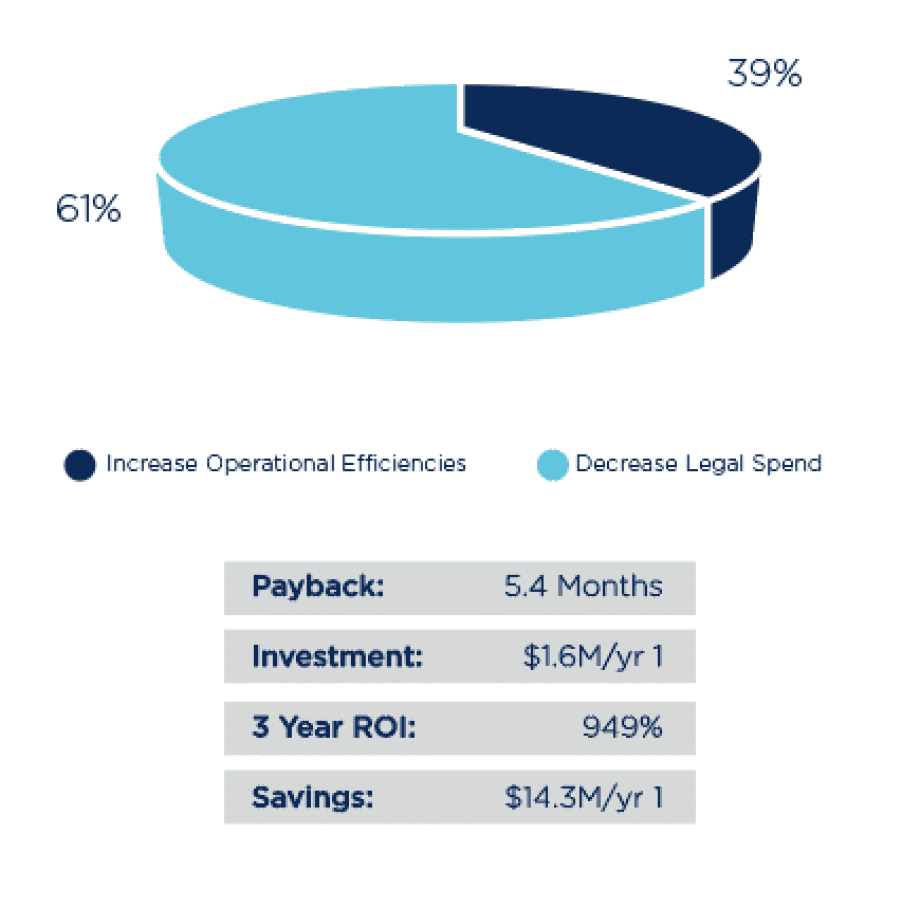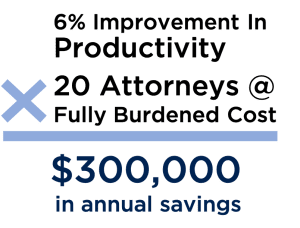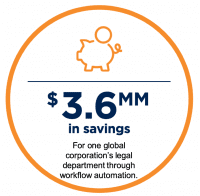5 Essential Uses for Tech in Legal Operations
The reality of corporate legal today is the pressure to do more with less. Today, legal tech tools provide a legal department with the ability to scale and make the best selections and decisions for their organization and the greater company.
Regardless if you’re in a foundational state or advanced, it makes sense to understand what a technological boost can do for your company. These five major elements are what make up a robust and realized ELM platform: Matter Management, Spend Management, Contract Management, Reporting & Analytics, and Workflow Automation.
 Matter Management
Matter Management
Challenged with managing thousands of new legal matters, both internally and externally, this process simply can’t continue being manual. Using technology allows the user to maintain the integrity of the process and eliminate risks by addressing several key tasks:
- Automating matters so the process is expedited, and human error is removed from matter management workflows.
- Establishing a central matter repository, a single source of truth so all users have access to the most current documents and assets, and allowing better collaboration.
- Increase matter visibility to aid oversight and optimization, as managers can have insight into the status and efficiency of every matter in the department.

By implementing matter management solutions, we’ve seen legal teams better manage matter workloads and reduce their resource and legal spend.
How much? In the chart shown, based on a company with $400 million in annual legal spend, ‘Decrease Legal Spend’ delivers the majority of the value.
Payback is rewardingly fast thanks to the improvements in matter management efficiencies and spend.
When matter management is combined with e-billing, the additional investment in an e-billing system more than doubled the already significant savings of a matter management system.

e-Billing & Spend Management
Working with outside counsel provides workload alleviation, but also provides new needs for controlling costs, engagement after a firm has been selected, and creating visibility to make sure the relationship is being optimized for the sake of efficiency. Where can technology deliver benefits?
- Automating audit trails, allowing for bill modifications (via reviews, adjustments, approvals, and rejections)
- Enforcing billing guidelines automatically, so billing is accurate and timely.
- Accurately forecasting and tracking of matter budgets and spend both on a per-matter and overall basis.
- Streamlining invoice processing and approval, which improves the review process, eliminates late payment penalties, and improves the working relationship between client and outside counsel.
By managing external spend and e-billing using an automated solution with solid reporting and analytics capabilities, a legal department can credit a reduction in annual legal spend as high as 10%.
Contract Management
The many contracts a Legal Ops team must help process include those with vendors, clients, partners, and any other connected entities that you’re doing business with. It’s another area where the right software platform can provide a big range of improvements:
- Executing contracts faster means there’s greater speed and agility in getting the work launched.
- Tracking contracts through completion ensures they’re being followed to the letter.
- Creating repeatable templates so new contracts for the same or similar work can be executed with greater ease and efficiency.
- Enforcing compliance in contract creation and execution through automatic, standardized processes helping to reduce human error and risk.
- Support version control of contracts, eliminating potential confusion and costs.
By having a dedicated central hub for contracts, companies never miss important documents or deadlines and have a way to assign-and-remind participants with automated reminder emails. This decreases friction and delays, and increases cost savings.
Reporting & Analytics
The ability to access your data in an easy-to-consume way has become increasingly important, since better visualization of that data allows Legal Ops to draw actionable insights based on analytics. How can you put that to work?
- Improving efficiencies throughout the department and company by optimizing processes and outcomes.
- Optimizing outside counsel selection based on costs and outcomes, so the right resource is assigned to the right matter.
- Analyzing budget and cost alignment per vendor, expenses, fees, and timekeepers.
 By turning to data analytics, more Legal Ops teams are utilizing granular metrics to guide their decision-making about employing outside counsel and other operational areas.
By turning to data analytics, more Legal Ops teams are utilizing granular metrics to guide their decision-making about employing outside counsel and other operational areas.
This “active management” that’s driven by data-based decision-making has gained traction in the last few years as costs have mounted, especially during phases like pre-trial discovery.
Here’s a simple calculation of the ROI just from using analytics to improve operational efficiencies.
 Workflow Automation
Workflow Automation
Automating legal workflows in a corporate environment accomplishes a host of efficiencies and advantages (as users like Yahoo and NetApp can attest) by…
- Accelerating processes by removing manual labor and delay by automating repetitive tasks.
- Eliminating human errors that can be potentially costly.
- Ensuring best practices are followed by making processes standardized and repeatable.
- Safeguarding compliance by archiving completed workflows for later audits and compliance review.
- Driving more effective and timely collaboration among participants, even including outside counsel and other members of the legal ecosystem.
 Extending legal best practices across the entire organization, as they’re embedded in non-legal department workflows such as HR and procurement processes.
Extending legal best practices across the entire organization, as they’re embedded in non-legal department workflows such as HR and procurement processes.
Example: NetApp decided to automate its Legal Operations processes. By just applying workflow automation to the many NDAs the legal department had to process every year, it netted $3.6 million per year in savings.





